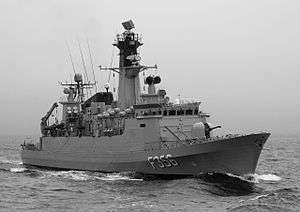Niels Juel-class corvette
 F356 Peter Tordenskiold | |
| Class overview | |
|---|---|
| Name: | Niels Juel class |
| Builders: | Aalborg Værft A/S |
| Operators: |
|
| Preceded by: | Triton-class corvette |
| Succeeded by: | Iver Huitfeldt-class frigate |
| Built: | 1978–1980 |
| In commission: | 1980–2009 |
| Planned: | 3 |
| Completed: | 3 |
| Scrapped: | 3 |
| General characteristics | |
| Type: | Corvette |
| Displacement: | 1,450 tonnes |
| Length: | 84 m (276 ft) |
| Beam: | 10.3 m (34 ft) |
| Draft: | 4.8 m (16 ft) |
| Installed power: |
|
| Propulsion: |
|
| Speed: | 30 knots (56 km/h; 35 mph) (with turbine) |
| Range: |
|
| Endurance: | 25 days |
| Complement: |
|
| Armament: |
|
The Niels Juel class was a three-ship class of corvettes formerly in service with the Royal Danish Navy. They were built in Denmark at Aalborg Shipyard and were launched in the period 1978–1980. In 1998–2000 the three vessels had a mid-life update, as well as a large update on the electrical systems.
The three ships were named Niels Juel (NATO abbreviation NIJU), Olfert Fischer (NATO abbreviation OLFI) and Peter Tordenskiold (NATO abbreviation PETO). All three vessels were named after famous Danish admirals, with the debatabale exception of Peter Tordenskjold, a Norwegian-born officer who served during the personal union of Norway and Denmark from 1415 to 1814.
These ships were replaced by the Iver Huitfeldt-class frigates.[1] All three ships were retired in 2009 [2] and were scrapped in 2013 at Munkebo, Denmark.[3][4]
Design
During the mid-life refit, the corvettes were modified to be able to use the StanFlex modular mission payload system; two module slots were installed aft of the superstructure.[5]
Duties

The corvettes played an active role in solving a wide spectrum of duties, including escort and protection of other vessels. They were built to the requirements of the Cold War era, notably the need for guarding and convoy duty in the strategically important Danish Belts. Like many assets built during this period, adapting it to changing needs in the post–Cold War period was challenging, but the Niels Juel class benefited from being built from the outset as austere, economical vessels with a large number of possible roles to play. Also among the various tasks for the corvettes were coast guard duties in Danish national waters, as well as intelligence gathering.
It was normal routine for the Danish corvettes to participate in international operations. On several occasions, the vessels took part in operations for NATO, UN, OSCE and coalition forces.
References
- ↑ http://forsvaret.dk/2ESK/Enheder/PS/
- ↑ http://forsvaret.dk/ssg/elementer/udsmykning/Pages/default.aspx
- ↑ http://www.maritimeparts.com/Maritimeparts.com-Blog/Quick-demolution-of-3-corvettes.html
- ↑ ""Westsund" towing first of fregat".
- ↑ Lok, Joris Janssen (24 April 2006). "New Danish combat support ships offer greater flexibility for NATO operations". International Defence Review. Jane's Information Group.
External links
| Wikimedia Commons has media related to Niels Juel-class (Denmark). |